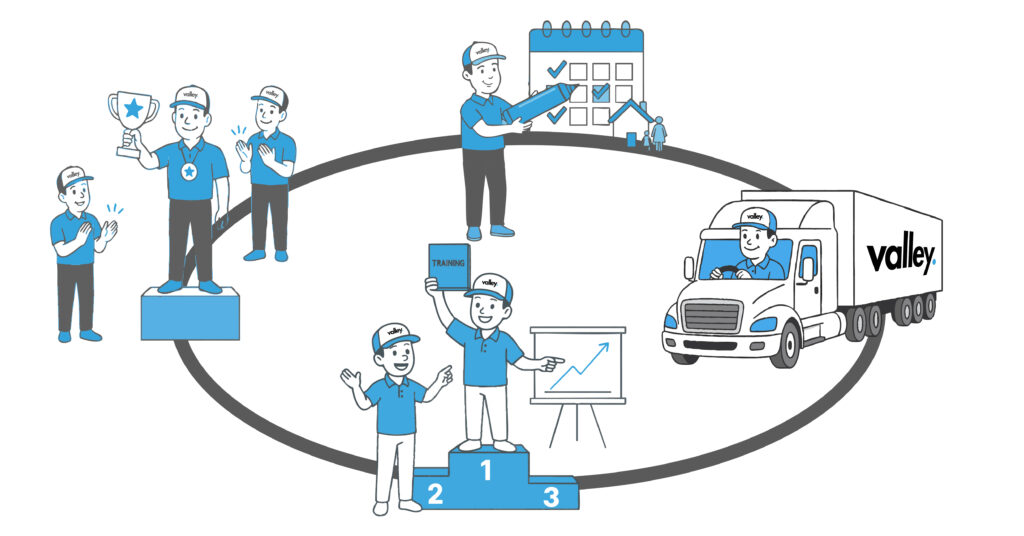Keeping Your Best Drivers: Retention Tactics That Work in 2025

One of the most expensive problems in trucking today is driver turnover. Every time a driver quits, fleets lose money on hiring, training, and onboarding new drivers. There are more hidden costs, like late deliveries, unhappy customers, and the trouble of having too many empty seats on the road. It costs between $5,000 and $8,000 to hire a new driver, and that’s not even counting the money lost during the transition. (FleetOwner, https://www.fleetowner.com/perspectives/ideaxchange/blog/55298004/driver-retention-strategies-navigating-the-challenges-of-the-trucking-industry-amidst-high-turnover-rates).
Retention isn’t just about saving money, it’s also about stability, safety, and creating a culture that makes drivers want to stay.
Real-World Proof: Mentorship and Incentives
A carrier in the Midwest set up a structured mentorship program for new drivers and offered tiered bonuses for keeping them. In just one year, their turnover rate went from 32% to only 15%. The savings on hiring were big, but the real value was in a stronger culture, more reliable deliveries, and drivers who cared about the company.
This case demonstrates that retention programs are not merely theoretical concepts. When done on purpose, they make results that can be measured. ndustry coverage shows that programs like mentorship and coaching improve driver engagement and retention (Geotab, https://www.geotab.com/blog/trucking-driver-retention/).
More Than a Paycheck
Pay that is competitive will always be important, but it’s not the only reason drivers stay. Drivers want to be respected, have chances to grow, and be recognized for their work. They want to be seen as more than just people who fill seats. Companies that make career paths, celebrate milestones, and let employees balance work and life often have happier employees, more loyal customers, and safer driving records.
For instance, some fleets now hold family events, give out small bonuses, or hold ceremonies to honor safety milestones. These small acts may seem simple, but they send a strong message that drivers are valued and seen. (TTNews, https://www.ttnews.com/articles/driver-hiring-q2-2025).
Retention Tactics That Work
Carriers that want to keep more drivers in 2025 can start with these tried-and-true methods:
- Well-organized programs for mentoring: To keep new drivers from leaving too soon, pair them with experienced mentors.
- Bonuses for keeping employees at different levels: Drivers feel valued and involved when they get small, regular rewards based on tenure.
- Clear career paths: Show drivers how they can move up in the company, from training to promotions.
- Respect and recognition: Honor safe driving, service milestones, and personal achievements.
- Work-life balance: Provide predictable schedules, flexible routes, or rotations to help avoid burnout.
Retention and Risk Go Hand in Hand
A stable team of drivers does more than just save money on hiring. It lowers risks for everyone. Fleets with happy, long-term drivers tend to have fewer accidents, better compliance, and fewer claims. Drivers who feel like they are part of the company are more likely to take care of their equipment, drive safely, and stay with the company long-term.
This also makes insurance companies stronger. It can be easier to get lower premiums if your fleet has a low turnover rate and better safety scores.
Building a Roadmap for Retention
To keep drivers, you don’t need to make big changes right away. Small, planned actions can have a big effect. Mentorship programs, recognition systems, and flexible scheduling are all good places to start. Over time, these efforts make the culture stronger, lower costs, and improve reliability.
Every driver who stays saves the company money, keeps the quality of service high, and improves the company’s reputation. Companies that focus on keeping their best employees now will not only keep them, but they will also have an advantage in a competitive market.
Common Mistakes in Retention Strategies
Not all attempts to keep people work. Some mistakes fleets often make are:
- Only thinking about pay: Raises help, but drivers may still leave if they don’t feel respected and balanced.
- Not paying attention to feedback: Asking drivers for their thoughts but not acting on them breaks trust.
- Making promises that are too good to be true: Programs announced but not kept up with can disappoint drivers.
- Policies that work for everyone: Retention plans should be tailored to the needs of specific regions, lanes, and drivers.
- Not paying attention to new hires: Many drivers quit in the first 90 days. Extra support early on makes a big difference.
FAQs on Driver Retention
Why is it so important to keep drivers?
- Keeping employees lowers hiring costs, improves safety, and increases customer reliability.
What is the cost of replacing a driver?
- Studies show that replacing a driver costs between $5,000 and $8,000, not including lost revenue.
What is the best way to keep people?
- There isn’t one solution. A mix of mentorship, recognition, and career opportunities works best.
Do younger drivers care about different perks?
- Yes. Younger drivers often value flexibility, growth opportunities, and recognition in addition to pay.
How can technology help with retention?
- Scheduling apps, driver portals, and recognition platforms improve communication and engagement.
Final Thoughts
Driver turnover is costly, but it is not inevitable. With mentorship, recognition, and clear career growth opportunities, fleets can reduce exits and build loyalty. Retention strategies don’t just save money, they create safer, stronger, and more reliable operations.
Every driver who stays strengthens the culture, protects margins, and builds resilience for the future. The fleets that act now will not only keep their best drivers but will also become employers of choice in a competitive industry.
